Today’s children are tomorrow’s movers and shakers. This has been a belief central to the ideology of Cambridge International School since its inception in 2012. Sought to provide a world-leading education, Cambridge International School spreads across two campuses at Shinmachi and Komazawa Daigakuku (both near Shibuya in central Tokyo). It is a private school envisioned to providing high quality educational programs to children of Pre-school age (age 1-3) through to Elementary School.
Expanding Horizons of Knowledge
Being a young school has not stopped Cambridge International School from excelling in offering the finest education and earning a reputation for quality education programs and teaching. Keeping in mind the inclusive development of children, the school’s course focuses on developing students both educationally and psychologically through its distinguishing learning strategies and scaffolding.
- All children, regardless of nationality, will have access to a safe, high-quality program with knowledgeable and well-trained staff and educators.
- A wide variety of materials with which children can play and experiment;
- Children making choices about activities’;
- Each child’s interests and abilities considered in the teacher’s plans so that each child can experience success and joy in learning;
- Interaction and communication during task activity to provide a meaningful, context-based rationale;
- Children’s health, nutrition, and social well-being, in an environment that respects and supports diversity.
The aforesaid are the school’s indicators of an appropriate early childhood program.
Children who enroll in schools are looking for great visions, visions that would complete their life and give them a purpose. The Cambridge International School delivers that wholeness and vision. Many of the difficulties in the world are the outcome of attitudes and beliefs that education for our modern times needs to examine. Cambridge School is one such place where both the teacher and the child explore not only the outer world, the world of knowledge but also our own thinking and behavior. Its philosophy, therefore, is “where one learns about the totality, the wholeness of life”.
All the aspects of the school’s curriculum embody its philosophy to foster critical reasoning and discussion in key discourses while at the same time establishing a critical awareness of the activities that it is engaged in. This underlying framework provides a means to establish not only a mastery of the principles and practice of rigorous and logically informed reasoning in the individual disciplines themselves but is part of an inquiry that extends beyond the mastery of the technical skills required of today’s world to an intelligence born of the observation and self-knowing.
Refurbishing Education with Novel Approach
As a student at Cambridge International School children is automatically enrolled in the school’s Jolly Phonics programme. Jolly Phonics is the primary literacy program used at Cambridge and is a thorough foundation for reading and writing. It uses the synthetic phonics method of teaching the letter sounds in a way that is fun and multi-sensory. The program features direct, daily, systematic teaching, and children learn how to use the letter-sounds to read and write words. The program covers letter–sound correspondences, blending for reading, segmenting for writing, letter formation, and tricky words.
Synthetic-phonics begins by teaching letters and their corresponding sounds and each phoneme, each letter, is important in this process. Once the child has learned a few of these then they begin to sound out the letters of a word and blend or synthesise these together in a sequence. By doing so, the child pronounces the word and this synthesising is essential for working out unknown words and to be able to read. Once students have blended a few times they can be read on sight.
Simultaneously, the school also emphasises on developing students skills to break words down into individual sounds. For example, if any learner wants to spell and write the word run, they break the word into its component sounds – r, u, and n. To spell or write a word it is necessary to know the letter(s) corresponding to the sound of the word. “I want to spell run, what sounds (phonemes) can I hear, and what letters (graphemes) are those sounds represented by?” This involves the breaking down of words into their constituent sounds (segmenting) in order to spell and write the word and is the reverse phonic skill to blending. Thus, children learn that the alphabetic code is reversible, if you can read a word you can spell it.
The Legacy of Imparting Quality Education
Standing above in its approach of nurturing students as independent learners and inquirers, Cambridge’s teaching philosophy is to develop learning and thinking skills in students. A very good example of this is its unique approach to help second language learners, predominately Japanese children to a point where they have native-like fluency in English. To achieve this, the school relies heavily on specially scaffold tasks designed to engage children in activities that promote the use of authentic English. Rather than engaging students in limited or memory-based practices that produce artificial responses, Cambridge ensures that children can clarify learning targets for themselves by sharing the criteria for success based upon student individual goals. Additionally, teachers also work on engineering effective questions leading to rich classroom discussion that further escalates the learning process.
Cambridge international school believe in developing a growth mindset in students, given that students receive descriptive feedback for their effort. The end result of this being students engaging themselves and processing their mistakes learn from them and creating a positively re-enforced cycle of back and forth communication.
With all this in place, the school aims to get students to act as instructional resources for one another. This would help in bringing a deeper understanding of learned material as children discuss and explain to each other and as a result raising learning to meta-level.
Montessori Method
Focusing on child-centered education and guided by the Montessori Method of Education, Cambridge International School zealously emphasis on the independence, freedom, and respect for a child’s natural, psychological, physical, and social development. Putting this in other words, Cambridge’s goal is not to just fill the child solely with facts from a prescribed course of studies, but, rather guide and cultivate the child’s natural desire to learn.
Dr. Maria Montessori had suggested that the optimal functioning of the child occurs through work within a prepared environment of five main areas: Practical Life, Sensorial, Mathematics, Language, and Cultural (which includes subjects such as geography, science, history, art, music, and physical education). Propelling the belief that the space within the school or the environment is considered the third teacher, the Cambridge International School has been designed in such a way that it supports all the educational needs and escalates the holistic development of its students. At Cambridge, the faculties too have a key role to play. In order to achieve the school’s mission they intentionally organize, support and plan for various spaces for children. The school’s daily schedules are planned to ensure that there is a balance between individual, small and large group activities, child- directed, and teacher-initiated activity and inside as well as outside experiences.
Architect of Cambridge International School
Florence Lam is the Principal at Cambridge International School. She has lived in Japan for 7 years and speaks Japanese fluently. She has previously worked for the Nagasaki City Board of Education where she taught English in junior high schools and elementary schools as well as being a kindergarten teacher in an international school prior to becoming principal.
One of her key beliefs is in developing and forging close relationships in the community and with parents. She has made it an important part of her job to communicate with the parents not only about developments in the school but to take time to speak with all the parents on a regular basis about their child’s development in the school. “I think it is important that in order to develop children’s behaviour it is necessary to explain and help children come to terms in understanding the social aspects of communication as well as learning English in an international environment. That their general behaviour and own actions are part of this communication; part of the culture of sharing with others. Since the school is currently going through a process of evaluation by the Tokyo Metropolitan Government Bureau of Social Welfare and Public Health and Education, we have to focus on a balance of Japanese and international culture that all the children are a part of”. She adds “By working closely with the parents helps foster a kindred spirit and mutual affection for the children. Children, teachers, and families join together to continually improve the system that supports our school community and so I think Cambridge will continue to expand.”









